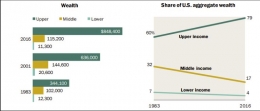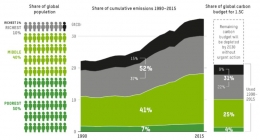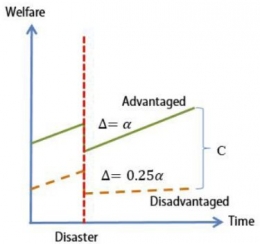Introduction
The 21st century is plagued with a looming climate crisis and rising inequality, the pandemic also stalled the progress against poverty. We often see these problems as separated and detached from each other. However, these problems are often interrelated and influence one another -- climate change can exacerbate poverty and inequality, and vice versa. In this article, we will explore some of the relationships between climate change, poverty, and inequality.
Current state of affairs
For the past few years, there have been many events that are attributed to climate change. From heat waves that are currently affecting Pakistan and India where surface temperature reached 50C (WMO, 2022) and Western North America in 2021 where it reached around 49C (Reuters, 2021) to a new record of CO2 concentration in the atmosphere, where in May 2022 it reached a new high of 422 ppm, beating the previous record of 419 ppm recorded in May 2021. Atmospheric methane concentrations have also recorded a historic increase of 17 ppb, up from 15.3 ppb in 2020. (NOAA, 2022). It is especially dangerous as methane is >25 times more potent in trapping heat than CO2 (EPA, 2021). Meanwhile, investigative reporting from the Guardian shows that oil and gas companies are still planning to invest more in so-called 'carbon bombs', these projects combined could release up to 646 gigatonnes of CO2 emissions, overshooting the carbon budget of 500 GtCO2 that were set by the IPCC to have a 50% chance of limiting warming below 1.5C.
On the other hand, gains in reducing global poverty and inequality have stalled as a result of the Covid-19 pandemic. In many countries, income growth for the bottom 40% saw a decline that is greater than national averages (UN, 2022). The average Gini Index of emerging and developing countries is estimated to increase by 6%, reversing the gains made since the global financial crisis in 2007 (UN, 2021). Generally, income inequality has increased not only in developing countries, but also in developed countries such as the US (UN, 2020). From 2001 to 2016, the median net worth of upper-income families in the US increased by 33% while middle-income families experienced a decrease of 20% and 45% for low-income families. Furthermore, only the top 20% of households gained wealth since the Great Recession in 2007, exacerbating inequality to a point where the richest 5% of families owned 248 times more wealth than the lowest 20% (Pew Research Center, 2020).

Climate change, by its own nature, is a very global issue that is affecting virtually all countries. However, the progression and severity of those impacts are deeply unequal and lean heavily on developing countries that have historically emitted less carbon than developed countries. Currently, the seven biggest carbon emitters are China, the US, the EU, India, Russia, and international transport, accounting for 65 percent of global emissions (UNEP, 2020).

Based on Figure 2, there is a pattern where the emissions of emerging countries are increasing while for developed countries it is stagnating. A second pattern can be noticed where in emerging countries, territorial-based emissions are larger than consumption-based emissions while in developed countries it is the reverse. This is because developed countries such as the US and EU are importing goods from emerging countries such as China or India for consumption. In short, some of the reduction in emissions is not actually reduced, but 'exported' to emerging countries.
Countries that emitted less are disproportionately impacted as those countries are located at hotspot regions of increasing temperature variability that are going to expose them to greater weather and climate shocks. Temperature fluctuations are projected to decrease in countries with high per capita GDP and increase in countries with low per capita GDP, resulting in a more stable temperature for developed countries in mid to high-latitudes but more fluctuate in low-latitude regions in where the majority of developing countries are located. This will cause a dual challenge of poverty and increasing climate instability in developing countries (Bathiany et al., 2018)



















